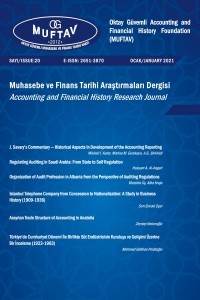THE PHILANTHROPIES OF THE SULTAN’S DAUGHTER AYŞE SULTAN FROM THE BEGINNING OF THE 17TH CENTURY, AND HER WAQF’S ACCOUNTING RECORDS
Awqaf (waqf as singular) are founded as charities that have certain laws and that are sustainable, such as fund-dependant, decentralised, voluntary democratic and nongovernmental organizations. At the same time, they are financial institutions that deal with social security, educational, cultural, religious affairs, public works, social aid and health investments.They are inspected by the government despite their financial and administrative autonomies, and these institutions have survived for centuries and provided services to society and enjoyed great monetary success. It is possible to read about their auditing and information about accounting in the Ottoman financial tradition from the books of accounts kept in the awqaf (foundations). The waqf culture has survived for centuries primarily because of this efficient, inspecting recording order.Ayşe Sultan was the daughter of Sultan Murad III (1574-1595) and Safiye Sultan. She dedicated her assets to a waqf which was setup by her husband Ghazi Ibrahim Paşa and herself. The tombs and fountain still survive.The waqf which was founded at the beginning of the 17th century survived for ages. The accounting books of the waqf reveal the accounting culture of social aid at that time. The books are recorded by siyaqat script and numbers and used the Merdiven (stair) method. The aim of this paper is to reveal, with the annual accounting records, how the waqf has a dynamism. This research was done with two different accounting records interval more than a decade. One of them is from 1607, the other one is from1729.
- ISSN: 2146-4928
- Yayın Aralığı: Yılda 2 Sayı
- Başlangıç: 2011
- Yayıncı: Oktay Güvemli Muhasebe ve Finans Tarihi Vakfı (MUFTAV)
Sayıdaki Diğer Makaleler
YAHYA ARIKAN İLE SÖYLEŞİ: İSTANBUL SMMM ODASI BAŞKANLIĞINDAN AYRILIŞI DOLAYISI İLE
XX. Yüzyılın Ortalarında Uygulamadan Yetişmiş Bir Muhasebe Düşünürü: SÜLEYMAN F. ŞAHİNBAŞ
Muhasebe ve Finans Tarihi Araştırmaları Dergisinde Yayınlanan Makalelerin Bibliyometrik Analizi
Sudi APAK, Mikail EROL, Seçil ÖZTÜRK
Batuhan GÜVEMLİ, Özcan UNUTKAN
Kurmaca Metinde MuhasebeBiliminin İzleri: Fuzulî’nin Şikâyetnamesi
Yusuf SÜRMEN, Yaşar BAYRAKTAR, Betül BAYRAKTAR
